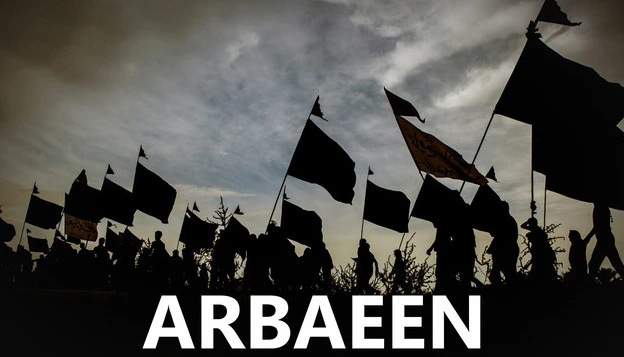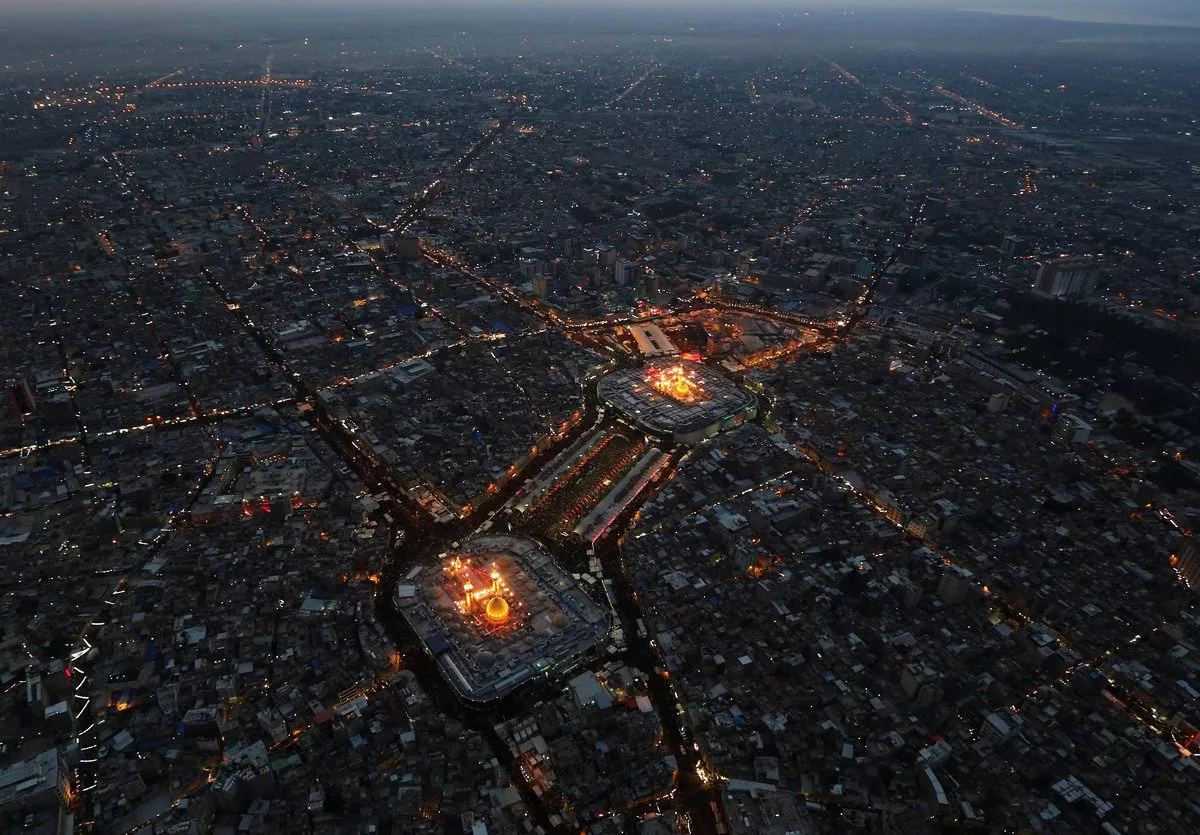The Day of Arbaeen :The Tragic Story Of Karbala

The Day of Arbaeen marks forty days after the Day of Ashura when Imam Hussain as and his family were killed in Karbala, the day Hussain ibn Ali was killed in the Battle of Karbala. Hussain ibn Ali as is the protector of Islam and the Grandson of Prophet Muhammad saws. who sacrificed his life for social justice.
What is the Day of Arbaeen?
Arbaeen, which means “forty” in Arabic, is a day to remember the shahdat of Imam Hussein, the grandson of the Rasool Allah Muhammad(pbuh), forty days after Ashura. In the year 61 AH (680 CE), Hazrat Imam Hussain (as) and 72 of His loyal followers were killed in a cruel way in the Battle of Karbala. In Islamic societies, the time of grief is usually forty days.
Actually, Yazid wanted Hussain to acknowledge his non-Islamic rule and corrupt leadership. However, Hussain refused to do so, as he was the grandson of Rasool Allah and also the source of Guidance appointed by Allah. Then Yazeed killed Imam Hussain as and his beloved family including his friends and companions in the battle of Karbala. The Day of Arbaeen is the day when the survivors of ahly bait including holy women and children visited the Karbala.
Jabir ibn Abdullah, a friend of the Holy Prophet (pbuh), was one of the people who traveled to the Karbala on the day of Arbaeen in the year 62 AH. Because He was sick and blind, Atiyya bin Saad stayed with him. His visit happened at the same time as those of the Prophet’s remaining female relatives and Imam Hussain’s son, Imam Zaynul Abidin (as). All of them had been held captive in Damascus by Yazid (la), the cruel Umayyad Caliph.
When does it take place?
The Day of Arbaeen falls annually on the 20th day of Safar, the second month of the lunar-based Islamic calendar.
In terms of the Gregorian calendar, Arbaeen falls on different days each year.
Significance of the Day of Arbaeen
One of the five markers of a believer, according to Imam Hasan Al-Askari (AS), is the performance of Ziyarat-e-Arbaeen, on the day of arbaeen along with reciting 51 raka of salah, saying “Bismillah” aloud, and performing sajda on dust. (Sheikh Tusi narrates this hadith in the book Tahthib.
Ziyarat of the Day of Arbaeen
As we are all aware, ziarat is a visitation, which is fundamentally the act of talking to and seeing our role models. Of course, doing the ziyarat of the day of Arbaeen while physically present in Kerbala is the physical embodiment of the ziyarat, but in practice, not every believer is able to do so.
According to Ahadith, reciting the Ziyarat of Imam Hussain (AS) even if one is not physically there at Kerbala will have the same impact as being there, provided the performer has a thorough understanding of the Imam’s rank and aspires to be like him.
The sky cried over Imam Hussain (AS) for forty mornings, rising crimson and setting red, according to Imam Muhamed al-Baqir (AS). We affirm our commitment to obeying and remaining loyal to our Imam as we come to the end of our 40-day period of remembering him.
We promise to uphold the path of justice and righteousness, reject injustice, and speak out against the oppressors of the day by performing the Ziyarat on the day of Arbaeen.
How do Shia Muslims mark the day of arbaeen?
Typically, on the day of urban people organize large marches in cities across the world to symbolize the eternal nature of Hussain’s revolution and to show they stand for social justice, compassion, and dignity. Shia Muslims start the pilgrimage to Karbala in the days and weeks preceding the actual day.
Alongside Najaf, where the first Imam and Hussein’s father, Ali, is buried, Karbala is the most important religious site for Shia Muslims after Mecca and Medina. Every year since, the number has been rising steadily from 17 million pilgrims to at least 25 million for the day of Arbaeen. People from all walks of life and all corners of the globe make the journey, despite the imminent threat of terrorists who have vowed to attack the pilgrims. But Shia Muslim strength is increasing every year for the day of Arbaeen.
Along the 80km stretch from Najaf to Karbala volunteers distribute free food and drinks to those undertaking the pilgrimage, as well as offering places to relax, wash, and sleep. The day of Arbaeen is now the largest annual peaceful gathering in the world, with numbers set to increase significantly every year.
Arbaeen and the Family of Imam Hussain as
Jaber Ibn Abdullah Ansari (r) was the name of the old man. When he heard that Imam Hussain (a.s.) and His companions had been killed and that the rest of His family had been jailed and treated badly, he hurried to Karbala with his loyal friends and followers. He had heard that the bodies of the people who died at Karbala were not buried.
When he got to Karbala, he saw that the Bani Asad, who lived in roving camps not too far from Karbala, had covered the bodies with sand to keep them from being destroyed, but they hadn’t been given a proper burial. With the help of his friends, Jaber (r) got the victims’ graves ready.
Jaber Ibn Abdullah (r) told his friends and companions that the reason he woke them up so early that morning was because in his dream he had seen the Holy Prophet, who told him that the captive caravan, which included Imam Ali Zainul Abedeen (as), His son Muhammad al Baqir (as), and Imam Hussain’s sisters, would arrive in Karbala that morning. The Holy Prophet (pbuh)had told him to go up to them and give them his greetings, salaams, and apologies. He told his friends that he had woken up after this, and he wanted them to come with him so they could go forward to meet the wagon and welcome the Prophet’s family.
At this time, the first sign of dawn could be seen in the east. One of Jaber’s (r) followers read the call to prayer, and everyone said their morning prayers and thanked Almighty Allah for letting them be the first pilgrims to the graves of the martyrs of Karbala and the first to greet the family of the Holy Prophet (pbuh) when they came back to the land that the martyrs’ blood had stained.
As soon as they were done praying, they saw a cloud of dust rise in the distance. This meant that a wagon was coming. Jaber (r) and his friends rode their horses to meet the Prophet’s (s) family and welcome them. As soon as they were close enough to hear him, they got off their horses and, with great respect, greeted Imam Ali Zainul Abadeen (as).
Jaber went up to the imam and, holding the reins of his horse, led him to his camp on the bank of the river. The rest of the group followed them. He told the Imam why he went to Karbala, what he saw, what he heard, and what he did while he was there. He also asked Imam Zainul Abadeen (as) in a polite way about how he and the women in the prophet’s family were treated. When asked this question, the Imam cried quietly for a long time and then answered softly:
“O’ Jaber, it is a story of pain that will be written in blood and tears for future generations to read! What pain should I tell you about that we went through here after the tragedy? The can’t be explained.”
When the women in the Prophet’s family saw the graves of their loved ones, they each fell off their camels in a fit of sadness. Each woman ran to the grave of her son, brother, father, or husband. Each woman poured out her heart at the grave of her closest relative, telling the story of all the bad things that happened to her.Hazrat bibi Zainab (sa) went straight to Imam Hussain’s (as) grave.
On Imam Hussain’s grave, Hazrat Zainab (sa) was heard saying,
“My dear brother, I have returned to you but without Sakina (sa), whom you committed to my care when you left. My dearest brother, your beloved Sakina (sa) took all the pain in silence and with strength until she couldn’t take it anymore and gave her soul to her Creator. Please forgive me, my dear brother, if I failed in any way to do what you asked me to do.”
This thing happened 40 days after Imam Hussain (as) was killed. Since then, Imam Hussain’s followers have gotten together every year to remember the terrible things that happened to Imam Hussain and His family on Ashura and in the 40 days that is called the day of Arbaeen.





